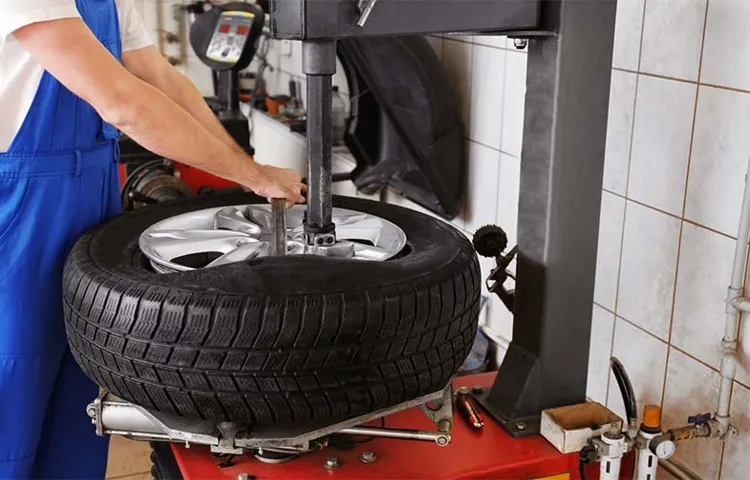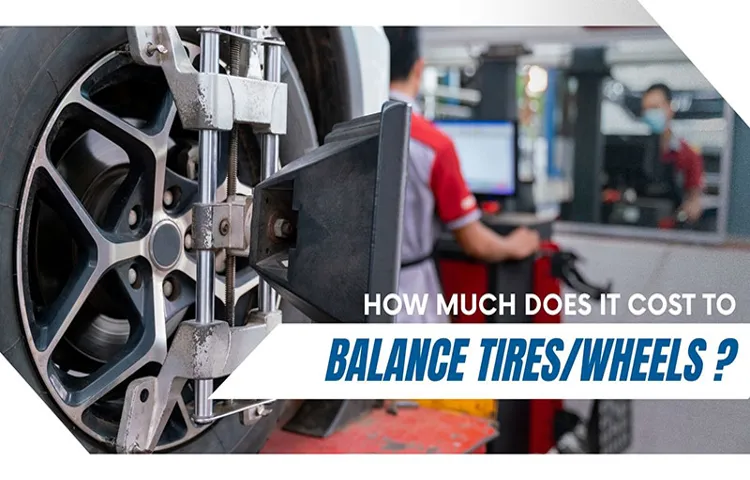Looking to change your tires? One question you may have is “How much does it cost to mount and balance tires?” Tire mounting and balancing are essential steps to ensure proper tire performance and safety. Not only do they ensure that your car drives smoothly but they also prevent uneven tire wear, which can result in costly repairs later on. The cost of tire mounting and balancing can vary depending on many factors such as the type of tire, the size of tire, and your location.
In this blog, we will dive into the details of tire mounting and balancing costs to help you understand what to expect and how to save money on these services.
Table of Contents
Understanding the Basics
When it comes to maintaining your car, you may wonder how much tire mounting and balancing costs. The cost of this service can vary depending on where you go and what type of tires you have. On average, the cost can range from $15-$45 per tire.
Some places may charge more if you have specialty tires or if the tires are larger in size. Tire mounting and balancing is important as it helps to ensure even wear on all four tires, leading to better handling and a smoother ride. It is recommended to have this service done every time you purchase new tires or when you switch from winter to summer tires.
Overall, while the cost may vary, this service is crucial for the longevity and performance of your tires.
What is Tire Mounting and Balancing?
Tire mounting and balancing are essential steps in properly installing new tires on your vehicle. Mounting involves placing the tire onto the wheel and then inflating it to the recommended pressure. Balancing is the process of equalizing weight distribution across the tire and wheel assembly, so it rotates evenly without shaking or wobbling.
This is achieved by attaching small weights to the rim of the wheel in specific locations, counterbalancing any areas that are heavier than others. Tire mounting and balancing ensure a smooth and safe ride, as unbalanced tires can cause vibrations at high speeds and affect the handling of the vehicle. So, whether you’re a car enthusiast or just looking for routine maintenance, make sure to have a professional perform tire mounting and balancing to ensure a comfortable, safe ride.

Why is it Important?
Understanding the basics of any topic is crucial for gaining a comprehensive understanding of it. The same goes for knowing why something is important. In general, understanding why something is important helps us to determine the value of it and how it impacts our lives.
In the case of why a particular topic matters, it serves as a framework for our learning and guides us in how we should approach it. For instance, if we know why something is essential, we are more likely to put in the extra effort to learn and apply it. Therefore, understanding the basics of why something is important is the foundation of learning and is necessary for building a strong knowledge base.
In this way, we can see that knowing why a particular topic is essential is indeed relevant and valuable.
Factors Affecting the Cost
When it comes to tire mounting and balancing, the cost can vary depending on a few factors. The type of vehicle you have can affect the cost as some vehicles require specialized equipment and expertise. Additionally, the type and size of the tires you’re getting mounted and balanced can also play a role in the cost.
Larger or more complex tires typically require more time and effort, which can increase the overall cost. Another factor that can influence the cost is where you go to get your tires mounted and balanced. Different shops may have varying prices, so it’s important to shop around and compare prices before making a decision.
Overall, the cost of tire mounting and balancing can range anywhere from $20 to $100 or more depending on the specific circumstances. When it comes to getting your tires serviced, it’s best to consult with a professional to get an accurate estimate and ensure that the job is done safely and correctly.
Type of Tire
When it comes to the cost of tires, there are numerous factors that can influence the price, and one of the most prominent is the type of tire. Depending on the material and construction, tires can be designed for different environments, weather conditions, and purposes, which can affect their performance and durability. For example, all-season tires that can handle rain and snow may be less expensive than specialized winter tires that provide better grip on ice and snow.
Similarly, high-performance tires that are designed for speed and handling may be more expensive than standard tires for daily driving. Other factors that can affect the cost of tires include the brand, size, and quality, as well as any additional features such as run-flat technology or noise reduction. Therefore, when shopping for new tires, it’s important to consider your driving needs and budget to find the best type of tire for your vehicle.
Size of the Tire
When it comes to purchasing new tires, there are several factors that affect the cost. One of the main factors is the size of the tire. Different vehicles require different tire sizes, and the larger the tire size, the more expensive the tire will typically be.
This is because larger tires require more material to create, and the manufacturing process can be more complex. Additionally, larger tires may require specialized equipment or tools for installation, which can drive up the overall cost. It’s important to consider the right tire size for your vehicle to ensure that you’re getting the best performance and value for your money.
Consulting with a professional tire dealer or mechanic can help you determine the right tire size and type for your vehicle. This will not only help you save money in the long run but also help keep you safe on the road.
Type of Vehicle
When it comes to shipping a vehicle, the type of vehicle you have plays a significant role in determining the cost. The cost of shipping a car is not the same as that of a motorcycle or a heavy-duty vehicle like a truck or an RV. The reason for this is that the weight, size, and shape of the vehicle impact the shipping cost.
For instance, shipping a small car may cost less than shipping an SUV because the latter requires more space on a carrier. Similarly, transporting a motorcycle may be cheaper than a car since it is smaller and lighter. Another factor that influences the cost is the distance the vehicle will travel.
Longer distances may cost more since more fuel and time are required. Additionally, the type of carrier used can also impact the cost. Enclosed carriers typically cost more than open carriers since they offer better protection against harsh weather and road debris.
Overall, understanding these factors can help you plan and budget for the cost of shipping your vehicle.
Cost Comparison
Are you wondering how much it costs to mount and balance your tires? The good news is that tire mounting and balancing services are relatively affordable, with prices typically ranging from $15 to $45 per tire. The cost will vary depending on the type of vehicle you have, as well as the size and brand of the tires. Typically, larger tires will cost more to mount and balance compared to smaller ones.
Additionally, if you plan to have any additional services performed, such as wheel alignment or rotations, this may add to the cost. It is important to keep in mind that while the cost of tire mounting and balancing may seem like an added expense, it is an essential step in ensuring the safety and performance of your vehicle. Not properly mounting and balancing your tires can lead to uneven wear and tear, poor road handling, and even potential accidents.
Investing in proper tire maintenance will ultimately save you money in the long run by avoiding costly repairs and replacements.
Dealer vs. Independent Mechanic
When it comes to car maintenance, the question of whether to take your vehicle to a dealer or an independent mechanic always arises. One factor to consider is the cost of the services. Dealerships tend to charge higher rates, mainly because of their brand name and location.
On the other hand, independent mechanics can offer lower rates because they have less overhead and can source parts and labor more affordably. It is vital to compare the prices for the same repairs or services, taking into account the quality of work, reputation, and warranties offered. Choosing an independent mechanic may save you money in the short term, but it may come at the expense of a lower-quality, less comprehensive service, with no manufacturer certification attached.
In contrast, dealerships offer greater convenience, on-site parts availability, and manufacturer-only expertise, which may be crucial for maintaining your vehicle’s warranty and resale value. Ultimately, it is up to you to weigh the pros and cons and choose the best option based on your budget and specific needs.
National Chains vs. Local Shops
When it comes to shopping for goods and services, the age-old debate between national chains and local shops is one that continues to divide shoppers. One of the most important factors that shoppers consider when making this decision is cost. While national chains often offer lower prices as a result of their economies of scale, local shops tend to put more care and attention into each sale, offering higher quality and more personalized products and services.
Ultimately, the choice between national chains and local shops comes down to a balance of cost and value. If you’re looking for the cheapest possible price, a national chain might be the better option. But if you want to support your local community and enjoy a more personalized shopping experience, a local shop is definitely worth the extra few dollars.
So, the next time you’re debating between Walmart and your local corner store, take a moment to consider what’s really important to you: saving money or establishing a connection with your community.
Average Cost
If you’re wondering how much tire mounting and balancing costs, the average price typically falls between $60 and $120. This cost can vary depending on the type of vehicle, size of the tires, and any additional services requested. It’s important to note that while some tire shops may offer lower prices, it’s crucial to choose a reputable business with experienced technicians.
Proper mounting and balancing are vital for safe driving and to prevent further damage to your tires or suspension system. Keep in mind that investing in good tires and regular maintenance can save you money in the long run by preventing costly repairs or accidents.
Average Cost of Tire Mounting and Balancing
The average cost of tire mounting and balancing can vary depending on a number of factors. Typically, the cost ranges from $15 to $75 per tire, but it can go up to $200 or more for high-performance tires. Many factors can affect the cost, such as the type and size of tire, the location of the service center, and the level of expertise of the technician doing the work.
Some places offer combo deals that include services like alignment and rotation, which can save you a little money overall. It’s important to do your research and compare prices before going to the service center to avoid getting overcharged. Overall, the cost of tire mounting and balancing is a necessary expense when it comes to maintaining the health and safety of your vehicle, and it’s worth paying for quality service to ensure your peace of mind on the road.
Conclusion
Well, it’s safe to say that the cost of tire mounting and balancing really depends on a variety of factors, including the type of tire, the size of the wheel, and the specific shop you go to. But one thing’s for sure, if you want your ride to be as smooth as a freshly paved road, it’s definitely worth investing in proper tire installation. And hey, if that means you have to scale back on your daily pumpkin spice latte budget, well, we won’t judge – at least you’ll be rolling in style!”
FAQs
What is included in tire mounting and balancing?
Tire mounting and balancing typically includes installing the new tires onto the wheels, balancing the wheels, and installing them onto the vehicle.
How much does tire mounting and balancing cost on average?
The cost of tire mounting and balancing can vary depending on the type of vehicle and the location, but the average cost is around $20 to $30 per tire.
Should I get my tires balanced and mounted at the same time?
Yes, it is recommended to get your tires balanced and mounted at the same time to ensure proper installation and performance.
How often should I get my tires balanced and mounted?
It is recommended to get your tires balanced and mounted every time you replace your tires or if you notice any balance issues while driving.
Can I mount and balance my own tires?
It is possible to mount and balance your own tires with the right equipment and knowledge, but it is recommended to have it done professionally to ensure safety and proper installation.
Is tire mounting and balancing necessary for all types of vehicles?
Yes, tire mounting and balancing is necessary for all vehicles that use tires.
What happens if I don’t get my tires mounted and balanced?
If you don’t get your tires mounted and balanced properly, it can result in uneven tire wear, vibrations while driving, and potential safety hazards.



